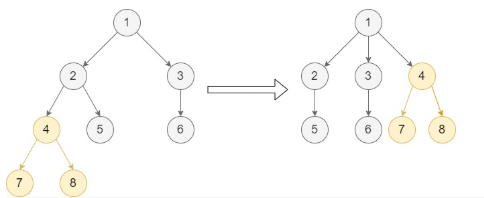文章目录
- 1. 题目
- 2. 解题
1. 题目
Given the root of an N-ary tree of unique values, and two nodes of the tree p and q.
You should move the subtree of the node p to become a direct child of node q. If p is already a direct child of q, don’t change anything. Node p must be the last child in the children list of node q.
Return the root of the tree after adjusting it.
There are 3 cases for nodes p and q:
- Node q is in the sub-tree of node p.
- Node p is in the sub-tree of node q.
- Neither node p is in the sub-tree of node q nor node q is in the sub-tree of node p.
In cases 2 and 3, you just need to move p (with its sub-tree) to be a child of q, but in case 1 the tree may be disconnected, thus you need to reconnect the tree again. Please read the examples carefully before solving this problem.
Nary-Tree input serialization is represented in their level order traversal, each group of children is separated by the null value (See examples).

For example, the above tree is serialized as [1,null,2,3,4,5,null,null,6,7,null,8,null,9,10,null,null,11,null,12,null,13,null,null,14].
Example 1:

Input: root = [1,null,2,3,null,4,5,null,6,null,7,8], p = 4, q = 1
Output: [1,null,2,3,4,null,5,null,6,null,7,8]
Explanation: This example follows the second case as node p is in the sub-tree of node q. We move node p with its sub-tree to be a direct child of node q.
Notice that node 4 is the last child of node 1.
Example 2:

Input: root = [1,null,2,3,null,4,5,null,6,null,7,8], p = 7, q = 4
Output: [1,null,2,3,null,4,5,null,6,null,7,8]
Explanation: Node 7 is already a direct child of node 4. We don’t change anything.
Example 3:

Input: root = [1,null,2,3,null,4,5,null,6,null,7,8], p = 3, q = 8
Output: [1,null,2,null,4,5,null,7,8,null,null,null,3,null,6]
Explanation: This example follows case 3 because node p is not in the sub-tree of node q and vice-versa. We can move node 3 with its sub-tree and make it as node 8’s child.
Example 4:

Input: root = [1,null,2,3,null,4,5,null,6,null,7,8], p = 2, q = 7
Output: [1,null,7,3,null,2,null,6,null,4,5,null,null,8]
Explanation: Node q is in the sub-tree of node p, so this is case 1.
The first step, we move node p (with all of its sub-tree except for node q) and add it as a child to node q.
Then we will see that the tree is disconnected, you need to reconnect node q to replace node p as shown.
Example 5:

Input: root = [1,null,2,3,null,4,5,null,6,null,7,8], p = 1, q = 2
Output: [2,null,4,5,1,null,7,8,null,null,3,null,null,null,6]
Explanation: Node q is in the sub-tree of node p, so this is case 1.
The first step, we move node p (with all of its sub-tree except for node q) and add it as a child to node q.
As node p was the root of the tree, node q replaces it and becomes the root of the tree.
Constraints:
The total number of nodes is between [2, 1000].
Each node has a unique value.
p != null
q != null
p and q are two different nodes (i.e. p != q).
来源:力扣(LeetCode)
链接:https://leetcode-cn.com/problems/move-sub-tree-of-n-ary-tree
著作权归领扣网络所有。商业转载请联系官方授权,非商业转载请注明出处。
2. 解题
- 先看下 p 在不在 q 的直接子节点里,在的话直接返回
- 再 DFS 确定 q 是不是 p 的子树节点,以及找到 p\q 的父节点
- 再分两种情况讨论,见注释
/*
// Definition for a Node.
class Node {
public:int val;vector<Node*> children;Node() {}Node(int _val) {val = _val;}Node(int _val, vector<Node*> _children) {val = _val;children = _children;}
};
*/class Solution {Node *pf = NULL, *qf = NULL;//父节点bool qisSubOfp = false;bool foundp = false;bool foundq = false;
public:Node* moveSubTree(Node* root, Node* p, Node* q) {for(auto node : q->children)if(node == p)//p是q的直接子节点,无需操作return root;Node* empty = new Node(-1);//建立空节点方便处理empty->children.push_back(root);dfs(empty, NULL, p, q);//q 不是 p 的子节点,p肯定不是rootif(!qisSubOfp){//找到 pf 子节点 p 的 iterauto it = find(pf->children.begin(),pf->children.end(),p);pf->children.erase(it);//删除之q->children.push_back(p);//p接到q的子节点中return root;}//q 是 p 的子树节点,p可能是rootauto it = find(qf->children.begin(),qf->children.end(),q);qf->children.erase(it);//断开 q 与 qfit = find(pf->children.begin(),pf->children.end(),p);//断开 p 与 pfit = pf->children.erase(it);//it指向下一个,即 pf child 中 p 的下一个位置q->children.push_back(p);//接入到q下面pf->children.insert(it, q);//pf 的子节点 原来 p 的位置 插入 qreturn empty->children[0];}void dfs(Node* root, Node* fa, Node* p, Node* q){if(!root) return;if(root == p){pf = fa;foundp = true;}if(root == q){if(foundp)qisSubOfp = true;qf = fa;foundq = true;}for(auto c : root->children)dfs(c, root, p, q);if(root == p)foundp = false;//回溯if(root == q)foundq = false;//回溯}
};
84 ms 28.9 MB
我的CSDN博客地址 https://michael.blog.csdn.net/
长按或扫码关注我的公众号(Michael阿明),一起加油、一起学习进步!

分析与预测)



适用于中小型系统...)
)



)







)

